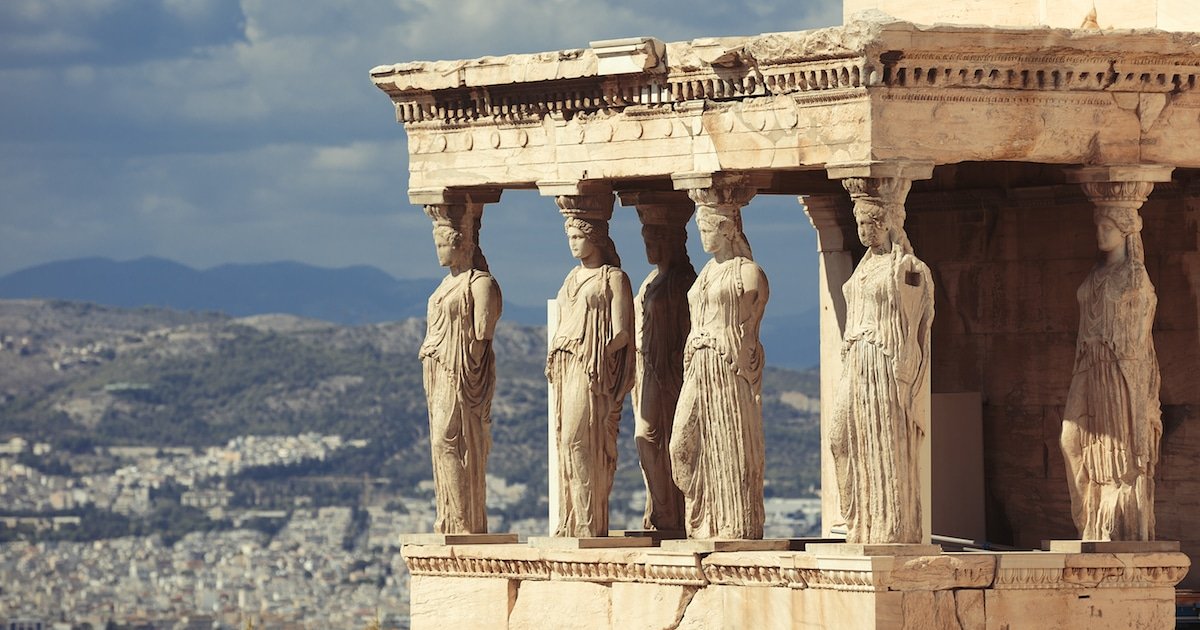By Daphne D. Martin
Walking down Euston Road on my way to the Tube, I see the familiar sight of the St Pancras Church caryatids looking down on me. These elegant sculpted figures stand in place of normal columns, supporting the building of which they are part. No one else seems to notice them or pay them much attention, but I stop to admire them, six ancient Greek women, standing tall, overlooking the London traffic; I feel proud looking up at them.
I know these girls well not only from the Acropolis, but from my own small village in Laconia, Karyai (Karyes), from where these maidens are said to have come. The 2nd century AD travel writer Pausanias described how they would have performed dances for Artemis of the Walnut Trees (Karyatis) in her open-air temple. There’s a replica of the caryatids in my village as well, which I remember clambering over since I was young. Standing at the top of a cliff overlooking the village’s entrance, our monument stands guard over the village of Karyai and establishes the caryatid’s Laconian roots, which no one else can lay claim to.
To contrast this, in the Acropolis Museum, five of the originals from the Athenian Acropolis are accompanied by an empty space – an empty space waiting for the sixth caryatid, stolen by Lord Elgin in 1802, and today in the British Museum, to join her Athenian sisters.
As a PhD student in Classics (Classical art and archaeology) at the University of Cambridge, I place emphasis on the importance of unification. This is where the crux of the issue lies: The sculptures taken from the Athenian Acropolis are integral parts of monuments and Greece is their home. From the moment in which there is an ideal locale for their display, and here I refer to the new Acropolis Museum (built in 2009), whose galleries will enhance their impact and appreciation due to their visual and physical proximity to the Acropolis, there is no excuse for them not to be returned, to be appreciated as close as possible to their original context. The impact of a full Parthenon frieze and pediments would be nothing short of magnificent, giving a sense of the monument’s true grandeur for the first time in over 200 years.
The compromise to display treasures which have never before left Greece’s shores in the British Museum is more than fair, and in fact could be used as an opportunity to discuss also the impact of these objects on British antiquarians and intellectuals. Neoclassicism was a current so strong it prompted men like Lord Byron to die for a country that was not theirs by blood (although it certainly was by love, hence the term philhellene) and this is something for which we Greeks are eternally grateful, as our bicentennial celebrations this year demonstrated. I believe the display of other treasures would highlight this special 200-year relationship between Greece and the UK in a more equal and egalitarian way than stubbornly holding on to the sculptures as if they were the singular prize. That would be true philhellenism, of which Lord Byron himself would be proud.
The British Museum has the power to make the moral choice, the just choice, in the current negotiations. As an institution which is dedicated to preserving human history through its art and culture, I have no doubt the museum and its trustees will have also taken the time to understand history’s lessons. In this way, the six caryatids could finally be together again.
Daphne D. Martin is a PhD candidate in Classics at the University of Cambridge.









